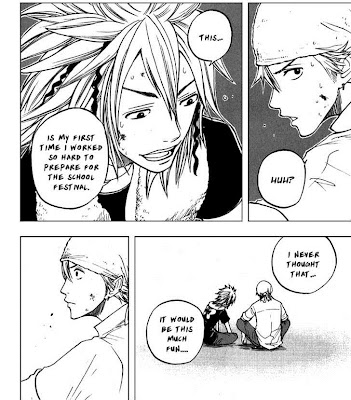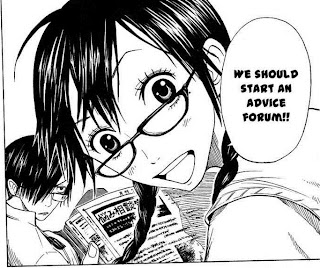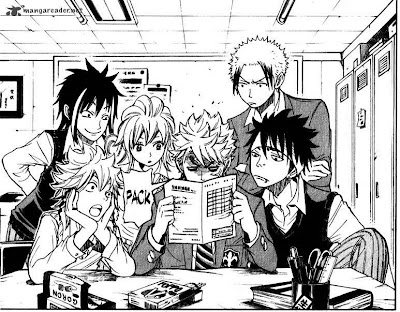Photo Essay
(read pictures from top right to bottom left)
At Mon Shiro High, not many students do so well. Some exceeds in grades while others...not so much. Shinigawa, who got an 18, is one of them. Mimi Ito, in her book "HOMAGO", gives us four key concepts that are involved in today's learning environment. We will be discussing about the first three. Shinigawa and his friends can apply these to their academic/non-academic learning.
"By shifting focus away from the individual and to the broader network of social relationships...social groups become key sites of analytic interests" (Ito 14). If a student did not know anyone in his/her class, he/she will most likely not participate because they are afraid they will make a mistake and be made fun of. In a classroom full of peers, the student will most likely participate because he'/she know his/her friends will not mock him/her for making a mistake. Genre of participation is the first key concept in Mimi Ito's HOMAGO.

Genre of participation can be broken down into two categories. The first one is friendship-driven. "For most youth, these local friendship-driven networks are their primary source of affiliation, frienships, and romantic partners" (Ito 16). Students sometime participate in some activities because of a love interest. What Shinigawa's friends did not know was that he was not going to attend high school after junior high. But after he met a girl at Mon Shiro High, he decided to go to high school.

The second category is known as interest-driven. "Interest-driven practices are what youth describes as the domain of the geeks...the kids identified as smart, different, or creative, who generally exist at the margins of teen social worlds" (Ito 16). If a group of students share a common interest, they will work come together to reach a common goal. At Mon Shiro High, different clubs are working together by decorating the school for the festival. These clubs include the art club, drama club, and yearbook club.
Networked public is the second concept. "Engagement with media is a constitutive part of how we learn to participate as culturally competent, social, and knowledgeable beings" (Ito 18). When students are not at school, one way to communicate is through technology and the internet.
Networked public can be broken down into two categories. Friendship-driven is the first one. "With friendship-driven practices, youth online activity largely replicates their existing practices of hanging out and communicating with friends" (Ito 19). One of the most common ways for students to connect with one another is through Facebook. Students can post on each other's wall, message one another, and invite each other to events and activities. If a student has a problem with his/her studies, he/she can find his/her classmates on Facebook.

The second category of networked public is known as interest-driven. "Through sites such as YouTube, fan forums, networked gaming sites...youth can access publics that are engaged in their particular hobby or area of interest" (Ito 20). There are other ways students can connect with one another online. One common method is known as mmorpg. Students can engage with one another like they do in real life. They can learn things from the game and from each other while playing. Shinigawa and his friends are playing their own kind of mmorpg to find a student who needs help with his studies.
One of the easiest and hardest thing to do is peer based learning. "A growing body of ethnographic work documents how learning happens in informal settings...rather than in an explicit instructional agenda" (Ito 21). Not many students want to go out for help. They rather work alone and try to find the answer themselves. Asking for help is the first step which is what Shinigawa is doing.
There are two categories that peer-based learning can be broken down into; the first is friendship-driven. "Our description of friendship-driven learning describes a familiar genre of peer-based learning...important lessons in growing up, giving kids an environment to explore romance, friendship and status just as their predecessor did" (Ito 22). Students can learn non-academic lessons from one another. Attitude and behavior are one of them. These fellow students learn how to be tough thanks to Shinigawa and his friend.

The other category is known at interest-driven. "In the case of kids who have become immersed in interest-driven publics, the context of who their peers are changes, as does the context for how reputation works, and they get recognition for different skills and learning" (Ito 22). Students can learn different things as their interest changes throughout the school year. They will find new friends to hang out with to learn these new things. If a student, who liked English, becomes interested in Math, he/she will go find students who are good at math to help him/her out whenever he/she will need it. This girl wants to become a troublemaker, and she knows Shinigawa is best at it.
Though learning isn't all that great, when it comes to friends, it can be one of the funnest things ever. Friendship-driven and interest-driven may both be different, but they both do share one common factor, friends.
Reflection
After re-reading Mimi Ito's HOMAGO, I realized that I only knew
about her ideas from a broader point of view. I did not fully understand her
ideas. Mini project one and two were done from my previous knowledge while mini
project three was done from my new knowledge about HOMAGO. Knowing more about
the concepts, I decided to revise my first mini project. I paraphrased each
section, so the essay won't be so long, repetitive, and boring. Randy and
Kedric both agreed that short and simple was good. They said it be boring to
read a long essay that they already read in class. I added the new knowledge
and tried to connect it with the old knowledge. It was hard trying to connect
everything to learning. I drifted off every once and awhile, so that became a
problem. I like how everything came out. Came out smoothly from my personal
opinion.
Work cited
Itō, Mizuko. Hanging Out, Messing Around, and Geeking Out: Kids Living and Learning with New Media. Cambridge, MA: MIT, 2010. Print.
Yoshikawa, Miki. "Yankee-kun to Megane-chan Manga." - Read Yankee-kun to Megane-chan Online For Free. N.p., 24 Oct. 2009. Web. 26 Apr. 2013. <http://www.mangareader.net/874/yankee-kun-to-megane-chan.html>.
Yoshikawa, Miki. "YANKEE-KUN TO MEGANE-CHAN." Manga Here. N.p., 5 May 2008. Web. 26 Apr. 2013. <http://www.mangahere.com/manga/yankee_kun_to_megane_chan/>.


















